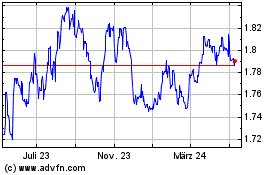NZ Dollar Rebounds After Upbeat New Zealand Inflation Data
17 April 2024 - 4:26AM
RTTF2
The New Zealand dollar strengthened against other major
currencies in the Asian session on Wednesday, after data showed the
consumer prices in New Zealand rose on quarter in the first quarter
of 2024, as expected.
Data from Statistics New Zealand showed that the consumer prices
in New Zealand were up a seasonally adjusted 0.6 percent on quarter
in the first quarter of 2024. That was in line with expectations
and up from 0.5 percent in the three months prior.
On a yearly basis, inflation rose 4.0 percent - above forecasts
for 4.5 percent and down from 4.7 percent in the previous three
months.
The upbeat CPI data from New Zealand spurred the traders to
expect that the Reserve Bank of New Zealand is unlikely to lower
its Official Cash Rate soon.
Traders reacted to a report showing a continued increase in U.S.
industrial production in the month of March, which added to
concerns about the outlook for interest rates. Traders also
remained cautious amid the geopolitical tensions in the
middle-east.
U.S. Fed Chair Jerome Powell indicated in remarks that rates are
likely to remain higher for longer amid a "lack of progress" toward
reaching the central bank's inflation goal. Fed officials,
including Powell, have repeatedly stated they need "greater
confidence" inflation is slowing before they consider cutting
interest rates.
According to CME Group's FedWatch Tool, the chances of a 25
basis point rate cut in June have tumbled to 16.4 percent compared
to 56.1 percent just a week ago.
In the Asian trading now, the NZ dollar rose to a 2-day high of
91.37 against the yen, from a recent 5-month low of 1.8108. The
kiwi may test resistance near the 1.76 region.
In economic news, data from the Ministry of Finance showed that
Japan posted a merchandise trade surplus of 366.5 billion yen in
March. That beat forecasts for a surplus of 107.4 billion yen
following the upwardly revised 377.8 billion yen deficit in
February.
Exports were up 7.3 percent on year to 9.469 trillion yen after
adding 7.8 percent in the previous month. Meanwhile, imports
slumped an annual 4.9 percent to 9.103 trillion yen after rising
0.5 percent a month earlier.
Against the Australian dollar, the kiwi advanced to a 2-day high
of 1.0861 from a recent low of 1.0919. On the upside, 1.07 is seen
as the next resistance level for the kiwi.
The kiwi edged up to 0.5908 against the U.S. dollar, from a
recent low of 0.5861. The next upside resistance level for the kiwi
is seen around the 0.61 region.
Moving away from nearly a 5-month low of 1.8108 against the
euro, the kiwi edged up to 1.7992. If the kiwi extends its uptrend,
it is likely to find resistance around the 1.76 region.
Looking ahead, Eurostat is scheduled to issue euro area final
consumer prices for March at 5:00 am ET in the European
session.
In the New York session, U.S. MBA mortgage approvals data, U.S.
EIA crude oil data and U.S. Fed Beige book report are slated for
release.
Euro vs NZD (FX:EURNZD)
Forex Chart
Von Mär 2024 bis Apr 2024

Euro vs NZD (FX:EURNZD)
Forex Chart
Von Apr 2023 bis Apr 2024
